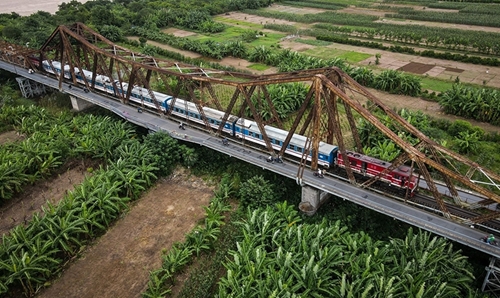A new vision is gradually taking shape with the Red River's riverbank and floating areas will be turned into a cultural industry center, connecting with neighboring areas.
"Green gem" in the heart of Hanoi
Turning the Red River's riverbank and floating areas into a cultural space with recreational activities, attractive tourism services, and sustainable ecological farm produce has captured the attention of experts and people having creative and unique ideas.
    |
 |
|
The Red River’s riverbank and floating areas are identified as a key creative space to build the capital's cultural industry center. |
Architect Tran Ngoc Chinh, Head of the Vietnam Urban Planning and Development Association, said that this is a breakthrough solution to effectively exploit the land, potential, and natural beauty of the Red River area. This is not only consistent with the general planning for the capital building by 2030 with a vision to 2050 approved by the Prime Minister in 2011, but also meets the people's aspirations for a long-awaited Red River cultural space.
This will turn the Red River into a green space axis, creating development momentum for the entire capital. It will also help increase the proportion of green space for the historic inner city area.
Dr. Le Thi Viet Ha for the Institute of Business Administration under the University of Economics of the Vietnam National University, Hanoi, said that developing a creative space based on the Red River’s potential will bring about significant values to the capital city. She took Cheonggyecheon stream which flows through the center of Seoul, the Republic of Korea as an example. The stream has been miraculously revived and becomes an ideal green tourist attraction and a symbol of Seoul.
However, many challenges must be solved, such as land management, construction order, urban order, environmental sanitation, and difficulties during the building of utility service and cultural and artistic facilities.
Synchronized vision to create breakthroughs
Living in Hanoi for over a decade, architect Emmanuel Cerise, Chief Representative of Ile de France region in Hanoi and Director of the Paris Region International Cooperation Support Agency in Vietnam (PRX-Vietnam), explained that developing cultural industry is not only the task of cultural workers, but also the community to create synchronization, breakthrough, and sustainability.
He highlighted the capital city’s gradual development of a fairly convenient transportation system, including railways and metro lines, to contribute to cultural industry development. He stressed the willingness to accompany Hanoi in preserving and promoting heritage and building an effective cultural industry center.
Realizing the dream of a creative cultural space in the capital city
According to Dr. Le Ngoc Anh, Director of the Hanoi Institute for Socio-Economic Development, the Capital Law allows Hanoi to develop a cultural industry center on the riverbank and floating areas of the Red River with a focus on five types of spaces, including the cultural-creative space and public space.
To this end, Hanoi needs to perfect mechanisms and policies, create a legal corridor to develop creative spaces and cultural industries with strengths, support cultural and creative enterprises, invest in transport infrastructure, diversify public-private partnership models and update planning in line with the orientation of the cultural industry development.
In a recent workshop, Permanent Vice Chairman of Hanoi municipal People's Committee Le Hong Son affirmed strong development of cultural industries coupled with perfecting the cultural market. Hanoi authorities have issued many mechanisms and policies to develop culture and cultural industries to meet increasing enjoyment needs of the public, domestic and international tourists.
In the current conditions, the city will renovate and convert old factories, headquarters and industrial parks into infrastructure that serves cultural development, promote public-private partnership and creativity and innovation of the private sector.
A new wave in the development of cultural industry is expected to be created, making culture a key economic sector, bringing high economic values and promoting the capital city’s image.
Translated by Mai Huong